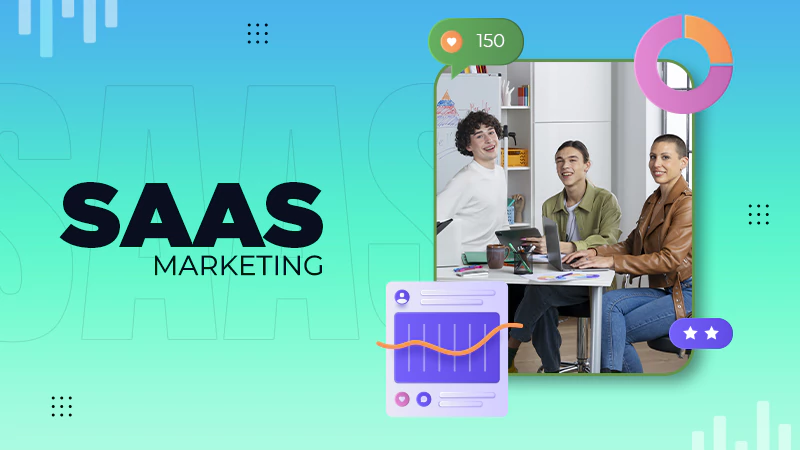Ans: The term SaaS for marketing describes how businesses sell and market their cloud-based software through relationships based on recurring revenue, user onboarding, and user retention.
What is SaaS Marketing? A Complete Beginner’s Guide (2025)
SaaS, or Software as a Service, is sweeping the digital landscape. From project management solutions like Asana to CRM (Customer Relationship Management) platforms like Salesforce, SaaS is everywhere. But how do these companies engage to reach their users, retain them, and grow in such a competitive space?
The answer is SaaS marketing, which stands for marketing Software as a Service, an approach that uses data and is intrinsically customer-first in the digital software as a service cloud space.
So, what does it include? In this comprehensive guide, we will cover what is SaaS marketing, how it differs from traditional marketing, and the best strategies and tactics.
What is SaaS Marketing?
SaaS marketing is a strategy and technique involved in marketing and selling software subscriptions delivered via the internet. Like traditional product marketing, SaaS includes planning and promotion of the software product, but it fundamentally differs because of the importance of acquiring users for long-term relationships.
SaaS companies operate on monthly or annual billing, and therefore, a strong long-term engagement is much more important than any one-time sale. Since user engagement extends far beyond acquisition for SaaS products, SaaS marketing strategies must also include fostering engagement, upselling opportunities, and churn reduction.
Why SaaS Marketing is Different
Traditional marketing is generally aimed at creating awareness and clinching a one-time sale. In contrast, SaaS marketing is all about an ongoing relationship with the customer. Here’s what’s unique about it:
1. Subscription-Based Revenue Model
You’re not selling a product once; you’re selling a service that users will pay for continuously (monthly, annually). This also turns the marketing parameters on its head, exploring the value of retention.
2. User Success
New users have to see value in your software continuously. So, marketing will include onboarding, troubleshooting, training, software support, and better UI/UX to engage users in the process and ensure they are ‘subscribed’ each year.
3. Freemium and Trials
SaaS companies typically provide freemium/preview plans to get users on board, so the marketing team’s job is to create the best experience to turn free users into paying customers.
4. Link Data Collection to Decision Making
SaaS marketing is data-driven because every user interaction is trackable (signups, usage, churn). This probably links to an analytical depth, and in the end, you are probably tracking your CAC, CLTV, churn rates, and other metric decisions.
5. Longer Sales Cycles (Especially in B2B)
The B2B SaaS process usually involves multiple champions in the buying process, meaning a longer sales cycle, a longer nurturing funnel, demos, and content to build trust should be employed in your marketing strategy.
Key Components of a SaaS Marketing Strategy
This marketing strategy must be adopted holistically to be successful at all stages of the customer journey. Here is the list of some of the building blocks of a B2B SaaS marketing strategy.
1. Define Your Ideal Customer Profile (ICP)
SaaS products often solve very specific problems. You will need to determine who the product is for — what industry the company is in, what job role they are in, the size of the company, what challenges they have, and what goals they are trying to achieve.
2. Positioning and Messaging
What is your differentiator? Spotlight your unique value proposition (UVP), but also make sure it resonates with your ICP and emphasizes benefits over features.
3. SaaS Content Marketing
Don’t teach your audience to use your product; educate them. Create blogs, whitepapers, webinars, and case studies to attract leads and user trust. Content should reference users’ pain points and position your product as the solution.
4. Search Engine Optimization & Organic Acquisition
Use keyword tools to discover terms that your users are searching for. Develop SEO optimized content around those subject areas to get high-intent organic traffic. Contact a great SaaS SEO agency to boost your SEO.
5. Paid Advertising
Get active on Google Ads, LinkedIn Ads, and YouTube Ads. You’ll want to get started with retargeting, branded search, and competitor bidding, which means you’ll be capturing demand that’s already in the funnel.
6. Product-Led Growth
Let your product do the marketing for you. If you have a free plan or free trial, ensure that it is user experience & conversion optimized.
Top SaaS Marketing Channels in 2025
After looking at the marketing strategy for SaaS, let’s look at the top SaaS marketing channels in 2025.
Here is where you should promote or market your SaaS product/service.
- LinkedIn (B2B Focus) – This platform is great for running account-based marketing campaigns, sharing thought leadership, and retargeting site visitors.
- YouTube and TikTok – Through these platforms, SaaS solutions can create educational content, tutorials, and feature walkthroughs.
- Organic SEO – It is still one of the highest ROI channels of online marketing. It is especially great for long tail keywords and cluster content strategies.
- Communities and Forums – Post on Reddit, Slack communities, and Discord groups – they are goldmines for SaaS products.
- Webinars and Virtual Events – These types of events are great for enterprise and mid-market SaaS for lead nurturing.
Essential Tools for SaaS Marketing
Here is the list of tools for SaaS marketing services. Most companies use these tools to get ahead in this competitive landscape.
| Function | Tools |
| CRM | HubSpot, Salesforce, Close |
| Email Marketing | ActiveCampaign, ConvertKit, Mailchimp |
| Analytics | Google Analytics 4, Mixpanel, Amplitude |
| A/B Testing | Optimizely, Google Optimize |
| SEO | Ahrefs, Semrush, SurferSEO |
| Automation | Zapier, Make (Integromat), Clearbit |
| Landing Pages | Unbounce, Webflow, Leadpages |
Conclusion
SaaS marketing is more than just selling the software; it’s about providing value over time. In an environment where users can cancel at any time, your marketing tactics need to go beyond attractive ads and towards building trust, establishing success, and creating ambassadors.
Whether you are a SaaS founder, SaaS marketer, or working in an agency that serves SaaS, learning the basics of growing your SaaS business in 2025 is a great way to ensure scalable growth and retention.
FAQs
Q. What does SaaS mean in marketing?
Q. How to do marketing for SaaS?
Ans: When we talk about SaaS marketing, we mean content creation, SEO, paid ads, email automation, free trials, and onboarding engagement strategies to win, convert, and retain users.
Q. How to become a SaaS marketer?
Ans: Start learning about digital marketing, familiarizing yourself with SaaS metrics, applications, and tools such as HubSpot, Google Analytics, and Ahrefs.
Q. What is the SaaS marketing funnel?
Ans: It is the entire user journey from awareness to advocacy — acquisition, activation, retention, and upselling.
Q. What is the ROI of SaaS marketing?
Ans: ROI is a measure of how SaaS marketing turns investment into revenue, typically tracked by CAC, LTV, MRR, and churn rate.

